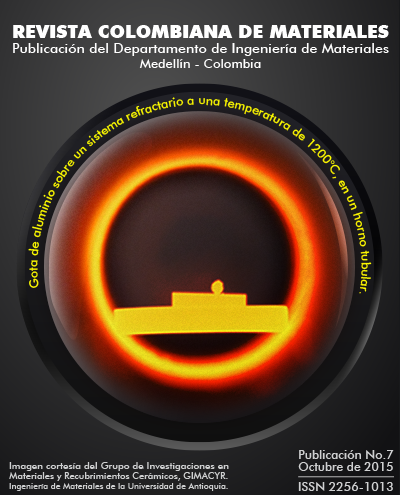BONE TISSUE ENGINEERING - SCAFFOLDS REINFORCED BY BIOACTIVE GLASS: STATE OF THE ART IN COLOMBIA
DOI:
https://doi.org/10.17533/udea.rcm.24752Keywords:
Tissue Engineering, Scaffold, Bioactive GlassAbstract
Downloads
References
C. Estrada, A. C. Paz, and L. E. López, “Ingeniería de Tejido Óseo: Consideraciones Básicas”, EIA, Vol. 5, pp. 93–100, 2006.
T. H. Qazi, D. J. Mooney, M. Pumberger, S. Geißler, and G. N. Duda, “Biomaterials based strategies for skeletal muscle tissue engineering: Existing technologies and future trends”, Biomaterials, Vol. 53, pp. 502–521, 2015. DOI: https://doi.org/10.1016/j.biomaterials.2015.02.110
R. S. Katari, A. Peloso, and G. Orlando, “Tissue Engineering”, Adv. Surg., Vol. Article in, p. 18, 2014.
P. Clark, G. Chico, F. Carlos, F. Zamudio, R. M. R. Pereira, J. Zanchetta, and J. Castillo, “Osteoporosis in Latin America: panel expert review”, Medwave, Vol. 13, No. 08, pp. e5791–e5791, 2013. DOI: https://doi.org/10.5867/medwave.2013.08.5791
A. Yovana and P. Mateus, “Técnicas empleadas en síntesis de nanocompuestos en ingeniería de tejido óseo”, Mutis, Vol. 4, No. 2, pp. 44–49, 2014. DOI: https://doi.org/10.21789/22561498.956
S. Deville, E. Saiz, and A. P. Tomsia, “Freeze casting of hydroxyapatite scaffolds for bone tissue engineering”, Biomaterials, Vol. 27, No. 32, pp. 5480–9, Nov. 2006. DOI: https://doi.org/10.1016/j.biomaterials.2006.06.028
A. V. Peño and D. A. Garzón-Alvarado, “Implantes scaffolds para regeneración ósea. materiales, técnicas y modelado mediante sistemas de reacción-difusión”, Rev. Cuba. Investig. Biomed., Vol. 29, No. 1, pp. 140–154, 2010.
M. N. Rahaman, D. E. Day, B. Sonny Bal, Q. Fu, S. B. Jung, L. F. Bonewald, and A. P. Tomsia, “Bioactive glass in tissue engineering”, Acta Biomater., Vol. 7, No. 6, pp. 2355–2373, 2011. DOI: https://doi.org/10.1016/j.actbio.2011.03.016
D. Lin, K. Yang, W. Tang, Y. Liu, Y. Yuan, and C. Liu, “A poly ( glycerol sebacate ) -coated mesoporous bioactive glass scaffold with adjustable mechanical strength , degradation rate , controlled-release and cell behavior for bone tissue engineering”, Colloids Surfaces B Biointerfaces, Vol. 131, pp. 1–11, 2015. DOI: https://doi.org/10.1016/j.colsurfb.2015.04.031
L. Kong, Y. Gao, G. Lu, Y. Gong, N. Zhao, and X. Zhang, “A study on the bioactivity of chitosan/nano-hydroxyapatite composite scaffolds for bone tissue engineering”, Eur. Polym. J., Vol. 42, No. 12, pp. 3171–3179, Dec. 2006. DOI: https://doi.org/10.1016/j.eurpolymj.2006.08.009
H. Li, C.-R. Zhou, M.-Y. Zhu, J.-H. Tian, and J.-H. Rong, “Preparation and Characterization of Homogeneous Hydroxyapatite/Chitosan Composite Scaffolds via In-Situ Hydration”, J. Biomater. Nanobiotechnol., Vol. 01, No. 01, pp. 42–49, 2010. DOI: https://doi.org/10.4236/jbnb.2010.11006
E. Silva Cuzmar, “Evaluación histológica y mediante microscopía eletrónica de retrodispersión (MER) dela suplementación de colágeno en soporte de cemento y microesferas de hidroxiapatita para mejorar su efecto osteoconductor”, Autónoma de Barcelona, 2013.
M. Rincón, A. Rodríguez, M. E. Londoño, and A. Echavarría, “Fabricación Y Caracterización De Una Matriz Tridimensional”, Rev. Esc. Ineniería Antioquia, Vol. 7, pp. 87–95, 2007.
J. González Ocampo, L. M. Acosta Ochoa, D. M. Escobar Sierra, and C. P. Ossa Orozco, “Plataformas De Hidroxiapatita Para Ingeniería De Tejidos Fabricadas Por La Técnica De Gel-Casting Combinada Con Infiltración De Espumas Poliméricas”, Rev. Colomb. Mater., Vol. 5, pp. 26–31, 2014. DOI: https://doi.org/10.17533/udea.rcm.19332
M. L. Fajardo Velasco and A. M. Lama Mejía, “Obtención de un sustituto óseo de fosfatos tricálcio y quitosana con refuerzo de celulosa”, Autónoma de Occidente, 2010.
J. R. Jones, “Review of bioactive glass: From Hench to hybrids”, Acta Biomater., Vol. 9, No. 1, pp. 4457–4486, 2013. DOI: https://doi.org/10.1016/j.actbio.2012.08.023
W. Li, M.-I. Pastrama, Y. Ding, K. Zheng, C. Hellmich, and A. R. Boccaccini, “Ultrasonic elasticity determination of 45S5 Bioglass(®)-based scaffolds: Influence of polymer coating and crosslinking treatment”, J. Mech. Behav. Biomed. Mater., Vol. 40C, pp. 85–94, Aug. 2014. DOI: https://doi.org/10.1016/j.jmbbm.2014.08.010
C. O. Correia, Á. J. Leite, and J. F. Mano, “Chitosan/bioactive glass nanoparticles scaffolds with shape memory properties”, Carbohydr. Polym., Vol. 123, No. 2015, pp. 39–45, 2014. DOI: https://doi.org/10.1016/j.carbpol.2014.12.076
K. Nazemi, P. Azadpour, F. Moztarzadeh, a. M. Urbanska, and M. Mozafari, “Tissue-engineered chitosan/bioactive glass bone scaffolds integrated with PLGA nanoparticles: A therapeutic design for on-demand drug delivery”, Mater. Lett., Vol. 138, pp. 16–20, 2015. DOI: https://doi.org/10.1016/j.matlet.2014.09.086
C. García, S. Ceré, and A. Durán, “Recubrimientos bioactivos sobre aleaciones de titanio depositados por la técnica sol-gel”, Rev. Fac. Ing., Vol. 37, pp. 129–140, 2006. DOI: https://doi.org/10.17533/udea.redin.343454
M. Monsalve, E. López, F. Vargas, F. Bolívar, H. Ageorges, and T. Rios, “Influencia de la técnica de proyección térmica en las propiedades mecánicas y en la bioactividad de recubrimientos de vidrio bioactivo”, Rev. Colomb. Mater., Vol. 5, pp. 100–106, 2014. DOI: https://doi.org/10.17533/udea.rcm.19577
E. Ciro Zuleta, N. Zapata, and E. López, “Elaboración de un cemento óseo de fosfato de calcio con una adición de biovidrio”, Bol. la Soc. Española Cerámica y Vidr., Vol. 54, pp. 84–92, 2015. DOI: https://doi.org/10.1016/j.bsecv.2015.03.006








